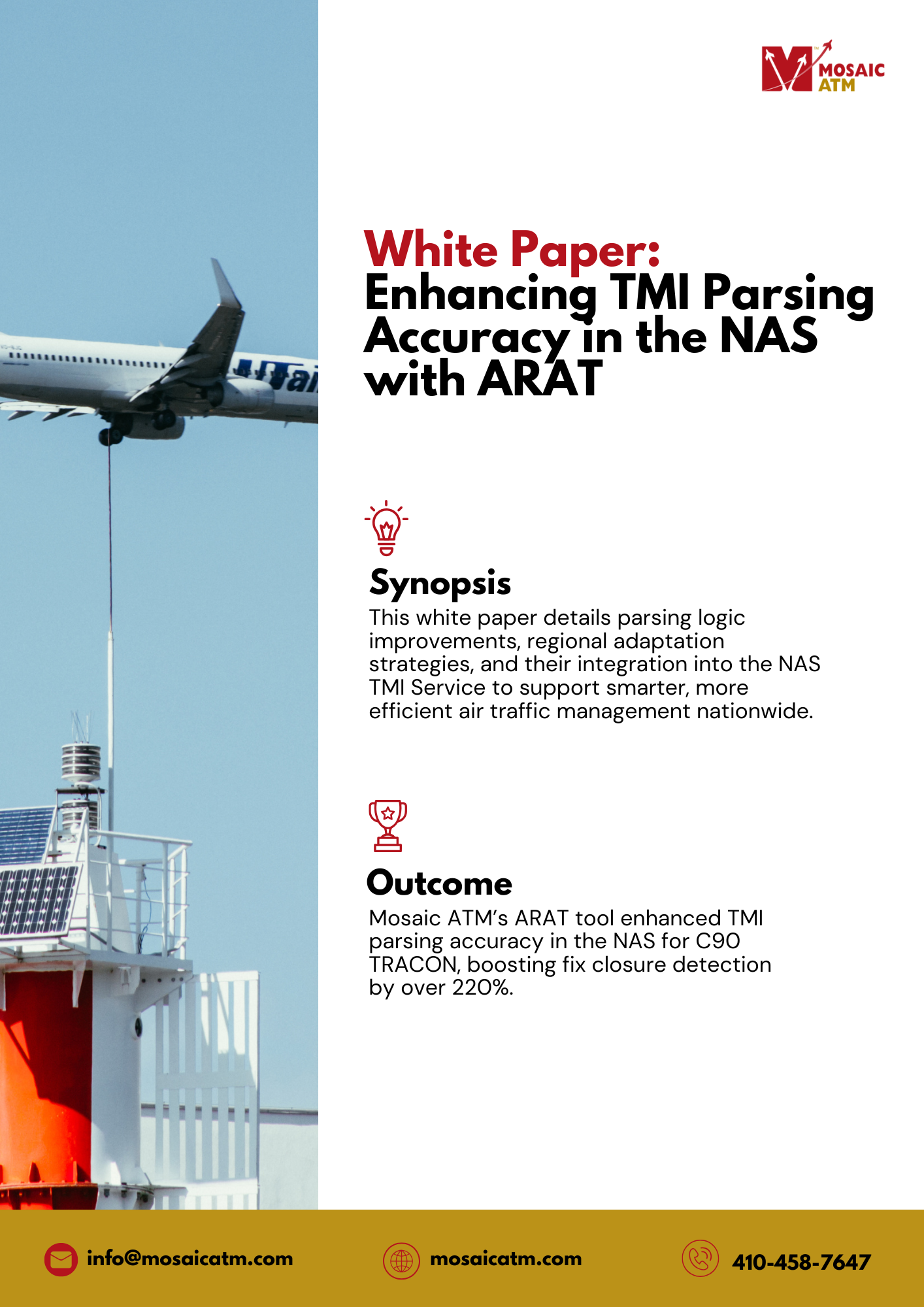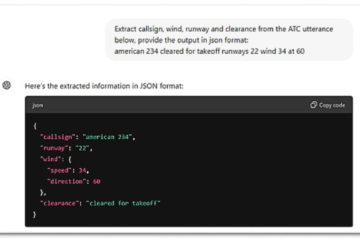Discover how Mosaic ATM’s ARAT tool enhanced TMI parsing accuracy in the NAS for C90 TRACON, boosting fix closure detection by over 220%. This white paper details parsing logic improvements, regional adaptation strategies, and their integration into the NAS TMI Service to support smarter, more efficient air traffic management nationwide.

Take Our Content to Go
Executive Summary
The National Airspace System (NAS) relies on timely and accurate Traffic Management Initiative (TMI) data to ensure efficient flight operations. The Alternate Route Availability Tool (ARAT), developed by Mosaic ATM as part of a NASA SBIR, leverages TMI data from SWIM to interpret and recommend alternate routes during air traffic constraints. However, translating TMI data into actionable insights is complex due to the variability in how restrictions are described.
The NASA DIP program has made significant progress in development of a NAS TMI Service that decodes TMI data from SWIM but is largely focused on the following areas: Dallas-Fort Worth TRACON (D10), Houston TRACON (I90), and New York TRACON (N90). This white paper presents a focused case study on improving TMI parsing for the C90 Terminal Radar Approach Control (TRACON), offering enhancements that extend benefits across the NAS. Implementing these parsing rules led to a measurable increase in the number of restrictions accurately decoded from SWIM data, and the ARAT team successfully collaborated with NASA DIP to integrate these parsing rules and TMI parsing accuracy in the NAS back into the NAS TMI Service.
Background
ARAT is designed to assist air traffic managers by utilizing TMI data and associating it with proposed flight routes. TMI data is aggregated from various sources in SWIM, including TFM Flow and OIS, to provide real-time traffic management information. Parsing these TMIs requires significant domain knowledge, particularly regarding the affected airspace. Recognizing this, prior work has been done by NASA for key TRACONs, including D10, N90, I90. This effort aimed to expand the TMI parser’s capabilities by improving adaptation logic and expanding its recognition of regional idiosyncrasies within the C90 TRACON.
Prior to this study, a very limited number of TMIs, specifically MITs and Fix Closures were extracted from SWIM for C90 TRACON, which includes major airports ORD and MDW.
Objectives
The objectives of this initiative were:
- To improve the detection and classification of fix closures and Miles-in-Trail (MIT) restrictions within the C90 region.
- To increase the alignment of TMIs with filed flight plans by refining parsing logic.
- To propose general parsing improvements applicable across all TRACONs in the NAS.
- To ultimately improve TMI parsing accuracy in the NAS.
Methodology
To support the parsing improvements, several datasets were analyzed:
- NTML: Used for understanding flight plans and resource allocations.
- TFM Flow: Provided real-time flow restrictions.
- OIS (Operational Information System): Supplied official FAA notices.
- NAS TMI Service: Core service for aggregating and parsing TMI data.
The ARAT team collaborated with NASA’s DIP program to analyze existing parsing behaviors and identify areas of enhancement, particularly focusing on the linguistic patterns used in C90 TMI messages.
Key Findings and Improvements
Fix Closure Detection Enhancements
Originally, the NAS TMI Service only recognized the keyword “ON” as an indicator of a fix closure. Analysis revealed that terms like “IN” and “OVER” were also used to indicate closures. Incorporating these terms significantly improved the accuracy of fix closure identification.
Example:
- “HUDAD,HRPER,WSTEX 15MIT ON KATZZ” now also recognizes variations like:
- “15MIT IN KATZZ”
- “15MIT OVER KATZZ”
Handling Abbreviated Fix Names
C90 TRACON commonly uses abbreviated track names (e.g., “A Track”, “B Track”) instead of full fix names. These abbreviations were mapped to full fix names using custom adaptation files:
| Abbreviation | Fix Name |
| A Track | ACITO |
| B Track | BACEN |
| C Track | CMSKY |
| D Track | DENNT |
| E Track | EARND |
| P Track | PETTY |
These mappings allowed the parser to correctly associate restrictions with flight plans filed using the full fix names.

Figure 1. Major Chicago Tracks and Departure Fixes

Figure 2. Examples of Abbreviated Fix Names in TMI data
Interpretation of Multiple Qualifiers
TMIs often include multiple qualifiers in a single restriction. Enhancements were made to interpret compound qualifiers accurately:
| Restriction Text | Translation |
| AS ONE PER AIRPORT | Single stream per airport |
| AS ONE X 10 IN MOBLE | 10 MIT over MOBLE as a single stream |
| AS ONE IN E PER AIRPORT | Single stream per airport over EARND |
| PER AIRPORT AS ONE IN B | Single stream per airport over BACEN |
| PER ROUTE PER AIRPORT | One stream per route and per airport |
Results for TMI Parsing Accuracy in the NAS
The implementation of these parsing improvements resulted in a measurable increase in the number of fix closures and MIT restrictions correctly parsed within the C90 TRACON. Visual analysis (referenced from internal figures) confirmed significant gains, particularly in scenarios previously missed due to ambiguous language or non-standard abbreviations.
In 2024, the TMI Service successfully parsed 306 fix closures from TFM-Flow and OIS using the legacy parsing logic. Since implementing the new parsing rules we developed, the system has already identified 982 fix closures in 2025. This represents an increase of over 220% for roughly half the year. These additional fix closures can now be linked to flights entering and exiting the C90 TRACON.

Figure 3. C90 Fix Closures Detected
Evaluating the impact of the enhanced parsing rules on MIT detection is more complex, as it involves identifying both previously missed MITs and those that were incorrectly assigned. One illustrative example is the restriction “A/B in A,” which appeared roughly 50 times across 2024 and 2025. This restriction should result in the closure of the fix BACEN, with ACITO designated as the alternate fix and a 10 MIT applied. However, before the new parsing rules were implemented, this same restriction produced a 10 MIT across both ACITO and BACEN without triggering any fix closure. Such misinterpretations of TMIs can distort the operational picture of the NAS, potentially leading to decisions based on inaccurate data.
Recommendations for TMI Parsing Accuracy in the NAS
- Continue refining adaptation files for other TRACONs with similar linguistic patterns.
- Introduce rule-based and machine-learning-driven approaches to adapt to evolving TMI syntax.
- Validate route resources against official FAA publications to reduce classification errors.
- Establish a standardized TMI syntax format or guideline for issuing authorities.
Conclusion
The TMI parsing accuracy in the NAS enhancements for C90 TRACON have improved the fidelity of TMI interpretation within the NAS TMI Service. These targeted rule additions and adaptation file updates have expanded the system’s ability to align restrictions with flight plans, improving decision support for traffic managers. The insights gained here offer a template for broader NAS-wide parsing improvements, supporting the ongoing modernization of U.S. airspace operations.


